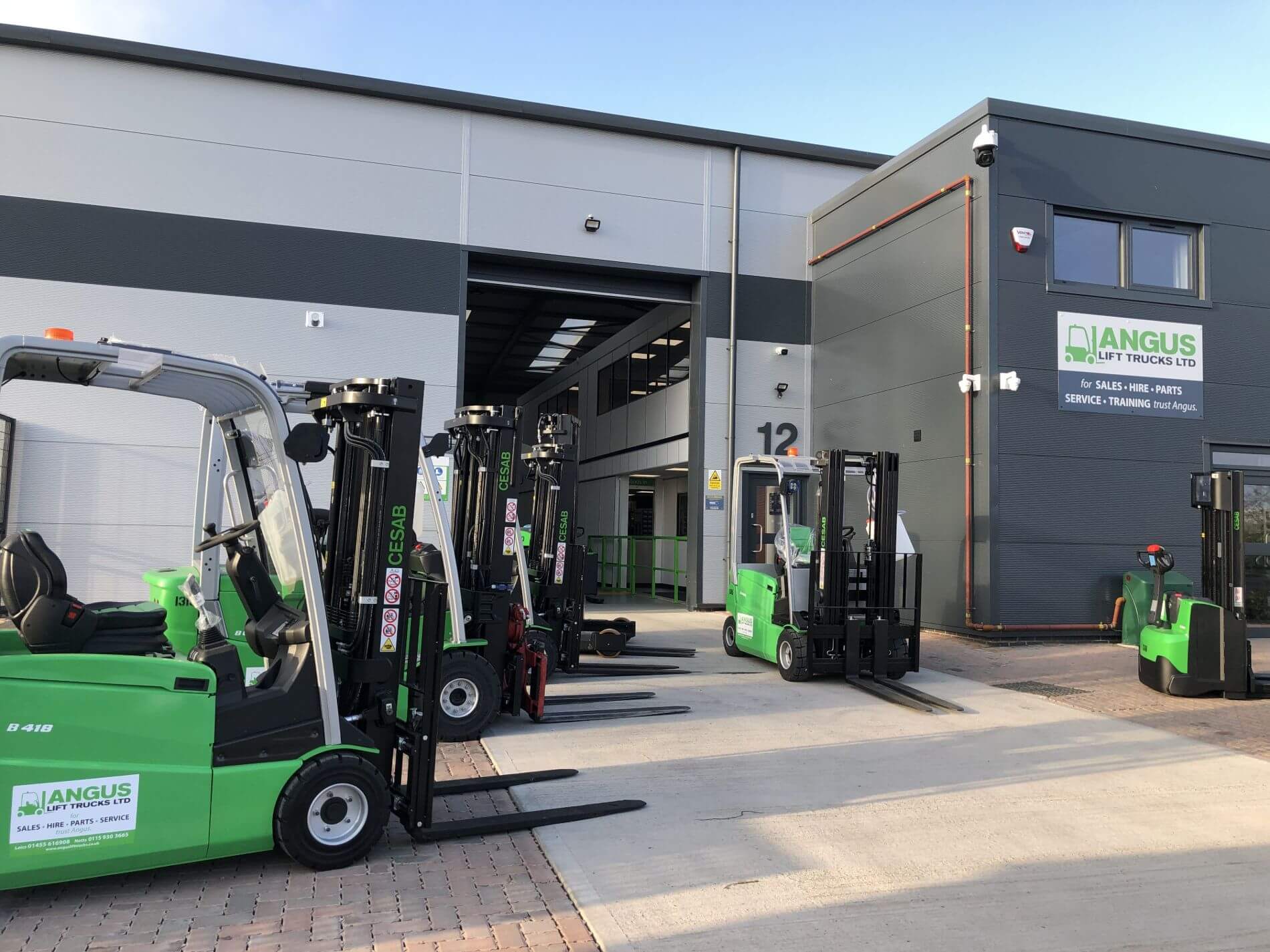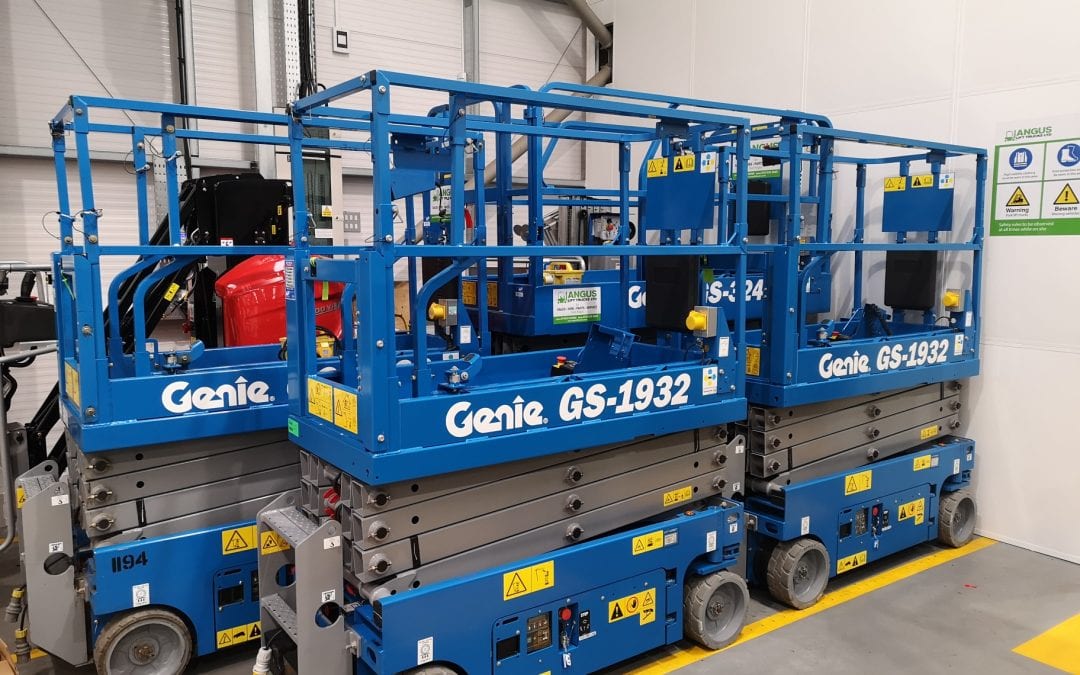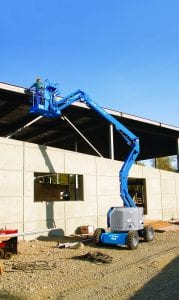In the world of machinery, many types of man and equipment lifts can help get the job done right. If you are working at height for an upcoming project, do you know which type of equipment you need?
While scissor lifts and cherry pickers are different access platforms with different benefits and use cases, they are also a lot alike, making it more challenging to know when you need to use one vs. the other.
If this is your first time hiring forklift equipment or you plan to invest in one of these machines, here’s what you need to know about scissor lifts and cherry pickers so you can make the right selection. So buckle up for our cherry picker vs scissor lift comparison.
Start by listening to our podcast episode on a comparison between scissor lifts and cherry pickers:
What is a Scissor Lift?
A scissor lift is a type of man lift mainly used in facility maintenance and construction. This piece of equipment gets its name from the design of its scissor-like lifting mechanism that is used when raising or lowering. You can go on any job site or take a look around any rental fleet and you’ll likely see one of these laying around, as they are one of the most used for those two purposes.
Specifically, there are two types of scissor lifts. There are terrain scissors and slab scissors, named after the application where they’re used. Terrain scissors have more grip to use on dirt or rough terrain, while slab scissors have non-marking tires made for use on concrete slabs or indoors.
What is a Cherry Picker?
A cherry picker is also known as a boom lift. This machine is a mobile elevating work platform (MEWP) cherry picker mechanism that relies on a hydraulic lifting system on a telescopic arm with a flat surface or bucket at the end. The bucket or flat surface is where people or equipment can be transported up or down.
Cherry pickers originally got their name from their first purpose—picking fruit. Since then, they have been modified and adjusted to use for maintenance, construction jobs, or generally lifting people.
Scissor Lift Benefits
There are benefits to use both types of equipment for different reasons. First, let’s take a look at the main benefits of using a scissor lift.
- More compact – If size is an issue, scissor lifts are more compact than cherry pickers when not in use, so they are great for storage.
- Cheaper – Whether you’re looking to hire or invest and buy a machine, scissor lifts are almost always more affordable.
- Simple commands up and down – Scissor lifts don’t move side to side, they only move up and down. This makes the commands and operations much easier.
- Cost-effective – Especially if you are buying one, you’ll get a return on your investment quickly with how much use you can get out of it.
- Customizable – Line up with your needs by adding accessories and extra functions like tilters or a turntable.
- Variety of Options – Can pick and choose among a variety of functions and sizes to meet your unique needs.
- Easy to maintain – Between the two, scissor lifts are easier to maintain over time.
If you need a machine that offers simple lifting functions at an affordable price and a manageable size, a scissor lift may be a better pick. If you are not quite sure about the types of scissor lifts you need, Angus Lift Trucks provide scissor lift sales and hire services in Leicestershire, Nottinghamshire, Northamptonshire, Birmingham, Warwickshire, Derbyshire, and East & West Midlands.
Cherry Picker Benefits
Now, let’s take a look at the benefits of a cherry picker or boom lift:
- Higher outreach capability – Do you have incredible heights you need to reach with your equipment? A cherry picker has a higher outreach capability than a scissor lift does.
- Pricier – While this isn’t necessarily a benefit, it’s worth noting here because this machinery could be rented out at a higher price to make the money back.
- Versatility – Very adaptable and can be adjusted to different heights or spots quickly for maximum efficiency.
- Safety – When a person is on a cherry picker, they have the safety of a cage surrounding them so there’s little to no falling risk.
- Can reach incredible heights – Telescopic cherry pickers or boom lifts can reach heights that a scissor lift can’t.
If you need to get access to incredible heights and don’t mind paying a bit more upfront, a cherry picker is likely a better selection for you.
When You Should Use a Scissor Lift
When should you use a scissor lift? You should opt for this machinery when hanging signage, replacing windows, cladding, or even curtain walling.
You usually will have the option to hire it temporarily or purchase it for long-term use, so depending on whether you’re facing a one-time project or a long-term need, you can get the best of both worlds with a scissor lift.
Scissor lifts typically come in diesel-powered or hybrid models that are versatile enough to use either outdoors or indoors.
In general, scissor lift trucks need flat surfaces for safe operation, however, some of these machines are built to handle uneven terrains. Typically, diesel powered scissor lift will come with the extra durability you need for outdoor operation.
Many scissor lifts come with an extendable platform. This feature allows multiple workers to use the platform at the same time. For complex installation, construction, or decoration work, this is a huge benefit that it is hard to ignore.
Looking to Buy or Hire

a forklift?
With 35+ years of experience, we offer our most competitive rates, flexible finance, 4h service promise & more!
When You Should Use a Cherry Picker
When should you use a cherry picker? You should use a cherry picker when you need to boost your access to high-up places, like when renovating a building or creating a new build. Another great use of a cherry picker is when stocking warehouse items, or generally any other use when you need to reach great heights.
The big cherry picker vs scissor lift advantage is that cherry pickers offer outreach rather than just vertical reach. This feature allows you to lift the platform up and over any objects that are in your way. As a result, cherry pickers have the versatility to access awkward places that are impossible for scissor lifts to reach.
There are two popular types of cherry picker mechanism that you might come across. The first, it’s the telescopic boom, which works something like a telescope. In short, the lift goes up and extends out, making it the perfect choice for going up-and-over obstructions that would be frankly impossible for a scissor lift to reach.
The other type of cherry picker that you might come across come into the category of articulate lifts. These machines offer an extra level of precision and maneuverability because they can move horizontally and vertically, but with more adjustments. While both telescopic and articulated lifts can reach tricky spots with lots of obstructions, articulate lifts provide that bit more flexibility
If you need more information about the right cherry picker for your project please contact our team at Angus, as we provide Boom Lifts for Hire and Sale for 35 Years in areas like Leicestershire, Nottinghamshire, Northamptonshire, Birmingham, Warwickshire, Derbyshire, and East Midlands & West Midlands.
When You Could Use Either
While the cherry pickers and scissor lifts are different enough that you should use each one for particular purposes, they are also similar enough that either option would work for some jobs. Some examples of the types of jobs when you could use either a cherry picker or a scissor lift include:
- Industrial manufacturing
- Outdoor events
- New builds or renovations
- Set staging
- Warehouses
- Agricultural
While there may be some crossover, one is still typically better than the other. If you aren’t sure which option is best for your current needs, you can always reach out to our friendly team for help.
Scissor Lifts and Cherry Pickers: Man Lifts You Can Count On
Both cherry pickers and scissor lifts are diverse machines that can aid in various functions centered around construction, warehousing needs, set staging, general maintenance, and cleaning.
In general, scissor lifts are simpler machines that are more affordable and work well for basic lifting jobs. Cherry pickers, on the other hand, should be relied on to access incredibly high elevations, particularly when renovating or in new construction. We are proud to offer both of these equipment options.
This post is also available in:
Français
Deutsch
Italiano
Português
Español
Български
Hrvatski
Eesti
Latviešu
Lietuvių
Polski
Português
Русский
Slovenčina
Slovenščina
Türkçe
Українська
Albanian
Čeština
Dansk
Nederlands
Ελληνικά
Magyar
Română








